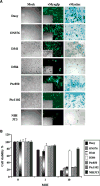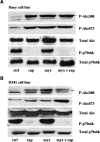Targeting human medulloblastoma: oncolytic virotherapy with myxoma virus is enhanced by rapamycin
- PMID: 17875723
- PMCID: PMC4380180
- DOI: 10.1158/0008-5472.CAN-07-1214
Targeting human medulloblastoma: oncolytic virotherapy with myxoma virus is enhanced by rapamycin
Abstract
We have shown previously the oncolytic potential of myxoma virus in a murine xenograft model of human glioma. Here, we show that myxoma virus used alone or in combination with rapamycin is effective and safe when used in experimental models of medulloblastoma in vitro and in vivo. Nine of 10 medulloblastoma cell lines tested were susceptible to lethal myxoma virus infection, and pretreatment of cells with rapamycin increased the extent of in vitro oncolysis. Intratumoral injection of live myxoma virus when compared with control inactivated virus prolonged survival in D341 and Daoy orthotopic human medulloblastoma xenograft mouse models [D341 median survival: 21 versus 12.5 days; P = 0.0008; Daoy median survival: not reached (three of five mice apparently "cured" after 223 days) versus 75 days; P = 0.0021]. Rapamycin increased the extent of viral oncolysis, "curing" most Daoy tumor-bearing mice and reducing or eliminating spinal cord and ventricle metastases. Rapamycin enhanced tumor-specific myxoma virus replication in vivo and prolonged survival of D341 tumor-bearing mice (median survival of mice treated with live virus (LV) and rapamycin, versus LV alone, versus rapamycin alone, versus inactivated virus: 25 days versus 19, 13, and 11 days, respectively; P < 0.0001). Rapamycin increased the levels of constitutively activated Akt in Daoy and D341 cells, which may explain its ability to enhance myxoma virus oncolysis. These observations suggest that myxoma virus may be an effective oncolytic agent against medulloblastoma and that combination therapy with signaling inhibitors that modulate activity of the phosphatidylinositol 3-kinase/Akt pathway will further enhance the oncolytic potential of myxoma virus.
Figures






Similar articles
-
Myxoma virus is a novel oncolytic virus with significant antitumor activity against experimental human gliomas.Cancer Res. 2005 Nov 1;65(21):9982-9990. doi: 10.1158/0008-5472.CAN-05-1201. Cancer Res. 2005. PMID: 16267023 Free PMC article.
-
Myxoma virus virotherapy for glioma in immunocompetent animal models: optimizing administration routes and synergy with rapamycin.Cancer Res. 2010 Jan 15;70(2):598-608. doi: 10.1158/0008-5472.CAN-09-1510. Epub 2010 Jan 12. Cancer Res. 2010. PMID: 20068158
-
Oncolytic virotherapy synergism with signaling inhibitors: Rapamycin increases myxoma virus tropism for human tumor cells.J Virol. 2007 Feb;81(3):1251-60. doi: 10.1128/JVI.01408-06. Epub 2006 Nov 15. J Virol. 2007. PMID: 17108021 Free PMC article.
-
The role of cell signaling in poxvirus tropism: the case of the M-T5 host range protein of myxoma virus.Biochim Biophys Acta. 2008 Jan;1784(1):228-37. doi: 10.1016/j.bbapap.2007.08.001. Epub 2007 Aug 14. Biochim Biophys Acta. 2008. PMID: 17905673 Review.
-
Myxoma virus and oncolytic virotherapy: a new biologic weapon in the war against cancer.Expert Opin Biol Ther. 2007 Sep;7(9):1415-25. doi: 10.1517/14712598.7.9.1415. Expert Opin Biol Ther. 2007. PMID: 17727330 Review.
Cited by
-
Cytokine synergy: an underappreciated contributor to innate anti-viral immunity.Cytokine. 2013 Sep;63(3):237-40. doi: 10.1016/j.cyto.2013.04.036. Epub 2013 May 18. Cytokine. 2013. PMID: 23693158 Free PMC article. Review.
-
Oncolytic Viruses as Therapeutic Tools for Pediatric Brain Tumors.Cancers (Basel). 2018 Jul 9;10(7):226. doi: 10.3390/cancers10070226. Cancers (Basel). 2018. PMID: 29987215 Free PMC article. Review.
-
Oncolytic efficacy of recombinant vesicular stomatitis virus and myxoma virus in experimental models of rhabdoid tumors.Clin Cancer Res. 2008 Feb 15;14(4):1218-27. doi: 10.1158/1078-0432.CCR-07-1330. Clin Cancer Res. 2008. PMID: 18281557 Free PMC article.
-
Bugs and drugs: oncolytic virotherapy in combination with chemotherapy.Curr Pharm Biotechnol. 2012 Jul;13(9):1817-33. doi: 10.2174/138920112800958850. Curr Pharm Biotechnol. 2012. PMID: 21740354 Free PMC article. Review.
-
Targeting the PI3K/Akt/mTOR pathway: effective combinations and clinical considerations.Drug Resist Updat. 2008 Feb-Apr;11(1-2):32-50. doi: 10.1016/j.drup.2007.11.003. Epub 2007 Dec 31. Drug Resist Updat. 2008. PMID: 18166498 Free PMC article. Review.
References
-
- Walker DA, Wilne S. Treatment of medulloblastoma in young children. Lancet Oncol. 2005;6:541–2. - PubMed
-
- Ribi K, Relly C, Landolt MA, et al. Outcome of medulloblastoma in children: long-term complications and quality of life. Neuropediatrics. 2005;36:357–65. - PubMed
-
- Gilbertson RJ. Medulloblastoma: signalling a change in treatment. Lancet Oncol. 2004;5:209–18. - PubMed
-
- Louis DN, Pomeroy SL, Cairncross JG. Focus on central nervous system neoplasia. Cancer Cell. 2002;1:125–8. - PubMed
-
- Parato KA, Senger D, Forsyth PA, Bell JC. Recent progress in the battle between oncolytic viruses and tumours. Nat Rev Cancer. 2005;5:965–76. - PubMed
Publication types
MeSH terms
Substances
Grants and funding
LinkOut - more resources
Full Text Sources
Other Literature Sources

